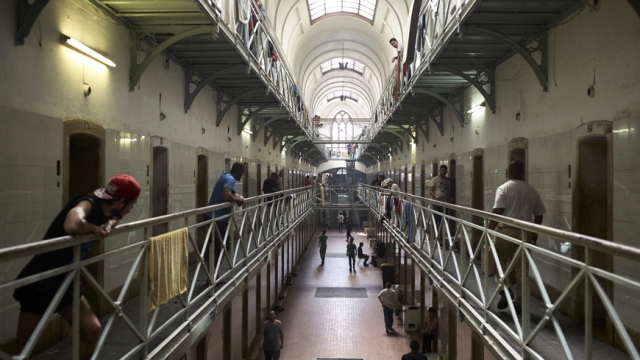Mid-term Impact of Covid-19 on European Prison Populations
Following the overall decrease of European prisons populations during the period of the lockdowns in spring, during the summer the incarceration rate remained stable in most European countries but started to grow in several prison administrations, according to a study by the University of Lausanne for the Council of Europe released today.
Despite this trend, the study shows that from 1 January to 15 September the average incarceration rate fell by 4.6% - from 121.4 to 115.8 inmates per 100,000 inhabitants - in the 35 penal administrations which provided these data for the four dates examined in the study. The decrease was due to a number of reasons, including the release of prisoners to prevent the spread of Covid-19.
The Council of Europe Annual Penal Statistics (SPACE) study “An evaluation of the medium-term impact of Covid-19 on prison populations” analyses trends in European prison populations during 2020 using four time references: before the pandemic (1 January), after the first month of the lockdowns (15 April), by the end of the lockdowns (15 June) and by the end of the summer (15 September).
The lockdowns of the European populations, which had been in place during only one month by mid-April, seem to have contributed to a trend of stability or reduction of the prison population rates. By 15 April, in 17 prison administrations the incarceration rate had fallen over 4%, and it remained stable in 29 prison administrations. Sweden, which did not confine its population, was the only country where the incarceration rate grew in the very short term.
The contribution of the lockdowns to the decrease of the prison populations is corroborated by an analysis of the situation by the end of the confinement. On 15 June, among the 43 prison administrations that provided data, the number of those where the prison population rates had fallen since January rose to 27, while 14 showed stable trends, and only Sweden and Greece had higher rates in June than in January.
During the summer, and without lockdowns, the downward trend in the prison population was reversed in 12 prison administrations, which had higher rates on 15 September than on 15 June: Monaco (+30%), Andorra (+22%), Norway (+16.8%), Luxembourg (+12.1%), Slovenia (+10.9%), Finland (+8.3%), Scotland (+7.7%), Cyprus (+7.2%), Denmark (+6.7%), Belgium (+4.8%), Romania (+4.7%), and Northern Ireland (+4.5%). The prison population remained stable in 22 prison administrations, while Bulgaria (-13.2%) and Montenegro (-7.7%) were the only two prison administrations —among the 36 which provided data– where the incarceration rate fell from June to September.
Overall, however, the prison population rates by mid-September were generally lower than at the beginning of 2020, corroborating that the year of the pandemic is a very particular in terms of crime and the action by the criminal law actors against it. In particular, when the prison population rates of the 35 prison administrations which provided data on 15 September are compared to the ones on 1 January 2020, the trends observed are the following:
- Decrease in 20 prison administrations (more than -4%): Montenegro (-21.1%), France (-13.4%), Bulgaria (-12.7%), Albania (-12.5%), Portugal (-12.5%), Italy (-10.8%), Lithuania (-10%), Netherlands (-8.8%), Scotland (-8.7%), Luxembourg (-8.4%), Finland (-7.6%), Latvia (-7.1%), Poland (-6.8%), Spain (Catalonia) (-6.3%), Cyprus (-6%), Czech Republic (-5.6%), Spain (State Administration) (-5.1%), England and Wales (-4.4%), Slovenia (-4.3%), Serbia (-4%).
- Stability in 11 prison administrations (between -4 and 4%): Azerbaijan, Belgium, Estonia, Hungary, Liechtenstein, Republic of Moldova, Monaco, Norway, Romania, Slovak Republic, Northern Ireland.
- Increase in 4 prison administrations (more than 4%): Andorra (+24.5%), Sweden (+5.8%), Denmark (+5.4%), and Greece (+5.2%).
One factor that contributed to the decrease of prison populations is that 25 prison administrations released inmates as a preventive measure against Covid-19: Albania, Andorra, Armenia, Austria, Azerbaijan, Belgium, Cyprus, Denmark, France, Iceland, Ireland, Italy, Liechtenstein, Luxembourg, Monaco, Norway, Portugal, Serbia, Slovenia, both administrations of Spain, Turkey, England and Wales, Northern Ireland, and Scotland released at least 143,000 inmates between March and September.
Turkey, which in January had the second largest prison population in Europe, released the vast majority of these prisoners (114,460 inmates, almost 40% of its penal population). Prison administrations which also released a high proportion of their prison population to prevent Covid-19 were Catalonia (Spain) (23%), Cyprus (23%), France (17%), Portugal (17%), Slovenia (16%) and Norway (15%). Slovenia, however, had already recalled by 15 June the inmates liberated during the first month of the lockdown.
The release of inmates as a preventive measure against Covid-19 does not seem to be the only cause of the trend to stability or decrease of the prison population rates. In fact, prison populations decreased also in several countries that did not release inmates for this reason.
According to Marcelo Aebi, director for the study, the European trends can be explained by several factors, notably a decrease in the activities of the criminal justice system due to the lockdown, the release of inmates as a preventive measure to reduce the spread of Covid-19, and a drop in crime produced by the lockdowns, which may have reduced opportunities for traditional crimes. This explanation is supported by the opposite trend observed in Sweden and by the fact that the decrease of prison populations stopped as soon as the lockdowns ended.
The study also points out that at least 3,300 inmates and 5,100 prison staff members were infected with Covid-19 across Europe until 15 September in the 38 prison administrations which provided data.
Survey “Prisons and prisoners in Europe in pandemic times”












